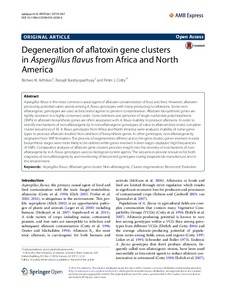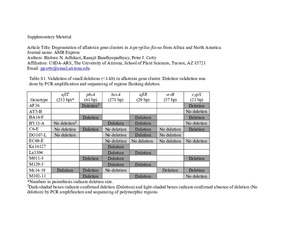| dc.contributor.author | Adhikari, B.N. |
| dc.contributor.author | Bandyopadhyay, Ranajit |
| dc.contributor.author | Cotty, P.J. |
| dc.date.accessioned | 2019-12-04T11:04:05Z |
| dc.date.available | 2019-12-04T11:04:05Z |
| dc.date.issued | 2016-08-31 |
| dc.identifier.citation | Adhikari, B.N., Bandyopadhyay, R. & Cotty, P.J. (2016). Degeneration of aflatoxin gene clusters in Aspergillus flavus from Africa and North America. AMB Express, 6(62), 1-16. |
| dc.identifier.issn | 2191-0855 |
| dc.identifier.uri | https://hdl.handle.net/20.500.12478/1332 |
| dc.description | Open Access journal; Published online: 31 August 2016 |
| dc.description.abstract | Aspergillus flavus is the most common causal agent of aflatoxin contamination of food and feed. However, aflatoxin-producing potential varies widely among A. flavus genotypes with many producing no aflatoxins. Some non-aflatoxigenic genotypes are used as biocontrol agents to prevent contamination. Aflatoxin biosynthesis genes are tightly clustered in a highly conserved order. Gene deletions and presence of single nucleotide polymorphisms (SNPs) in aflatoxin biosynthesis genes are often associated with A. flavus inability to produce aflatoxins. In order to identify mechanisms of non-aflatoxigenicity in non-aflatoxigenic genotypes of value in aflatoxin biocontrol, complete cluster sequences of 35 A. flavus genotypes from Africa and North America were analyzed. Inability of some genotypes to produce aflatoxin resulted from deletion of biosynthesis genes. In other genotypes, non-aflatoxigenicity originated from SNP formation. The process of degeneration differed across the gene cluster; genes involved in early biosynthesis stages were more likely to be deleted while genes involved in later stages displayed high frequencies of SNPs. Comparative analyses of aflatoxin gene clusters provides insight into the diversity of mechanisms of non-aflatoxigenicity in A. flavus genotypes used as biological control agents. The sequences provide resources for both diagnosis of non-aflatoxigenicity and monitoring of biocontrol genotypes during biopesticide manufacture and in the environment. |
| dc.description.sponsorship | United States Department of Agriculture |
| dc.format.extent | 1-16 |
| dc.language.iso | en |
| dc.subject | Aspergillus Flavus |
| dc.subject | Biocontrol |
| dc.subject | Evolution |
| dc.subject | Contamination |
| dc.subject | Genotypes |
| dc.title | Degeneration of aflatoxin gene clusters in Aspergillus flavus from Africa and North America |
| dc.type | Journal Article |
| dc.description.version | Peer Review |
| cg.contributor.crp | Maize |
| cg.contributor.affiliation | University of Arizona |
| cg.contributor.affiliation | International Institute of Tropical Agriculture |
| cg.coverage.region | Africa |
| cg.coverage.region | East Africa |
| cg.coverage.region | North America |
| cg.coverage.region | West Africa |
| cg.coverage.country | Burkina Faso |
| cg.coverage.country | Kenya |
| cg.coverage.country | Nigeria |
| cg.coverage.country | Senegal |
| cg.coverage.country | United States |
| cg.isijournal | ISI Journal |
| cg.authorship.types | CGIAR and advanced research institute |
| cg.iitasubject | Aflatoxin |
| cg.iitasubject | Food Security |
| cg.journal | AMB Express |
| cg.howpublished | Formally Published |
| cg.accessibilitystatus | Open Access |
| local.dspaceid | 79257 |
| cg.targetaudience | Scientists |
| cg.identifier.doi | https://dx.doi.org/10.1186/s13568-016-0228-6 |


